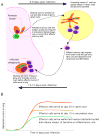Cell-mediated immune responses in tuberculosis
- PMID: 19302046
- PMCID: PMC4298253
- DOI: 10.1146/annurev.immunol.021908.132703
Cell-mediated immune responses in tuberculosis
Abstract
Tuberculosis is primarily a disease of the lung, and dissemination of the disease depends on productive infection of this critical organ. Upon aerosol infection with Mycobacterium tuberculosis (Mtb), the acquired cellular immune response is slow to be induced and to be expressed within the lung. This slowness allows infection to become well established; thus, the acquired response is expressed in an inflammatory site that has been initiated and modulated by the bacterium. Mtb has a variety of surface molecules that interact with the innate response, and this interaction along with the autoregulation of the immune response by several mechanisms results in less-than-optimal control of bacterial growth. To improve current vaccine strategies, we must understand the factors that mediate induction, expression, and regulation of the immune response in the lung. We must also determine how to induce both known and novel immunoprotective responses without inducing immunopathologic consequences.
Figures



References
-
- Rich A. The pathogenesis of tuberculosis. Baltimore: Chales C Thomas; 1944.
-
- North R, Jung Y. Immunity to tuberculosis. Ann Rev Immunol. 2004;22:599–623. - PubMed
-
- Flynn J, Chan J. Immunology of tuberculosis. Ann Rev Immunol. 2001;19:93–129. - PubMed
-
- Waterston R, Lindblad-Toh K, Birney E, Rogers J, et al. Mouse Genome Sequencing Consortium. Initial sequencing and comparative analysis of the mouse genome. Nature. 2002;420:520–62. - PubMed
-
- Cole ST, Brosch R, Parkhill J, Garnier T, Churcher C, et al. Deciphering the biology of Mycobacterium tuberculosis from the complete genome sequence. Nature. 1998;393:537–44. - PubMed
Publication types
MeSH terms
Substances
Grants and funding
LinkOut - more resources
Full Text Sources
Other Literature Sources
Medical

